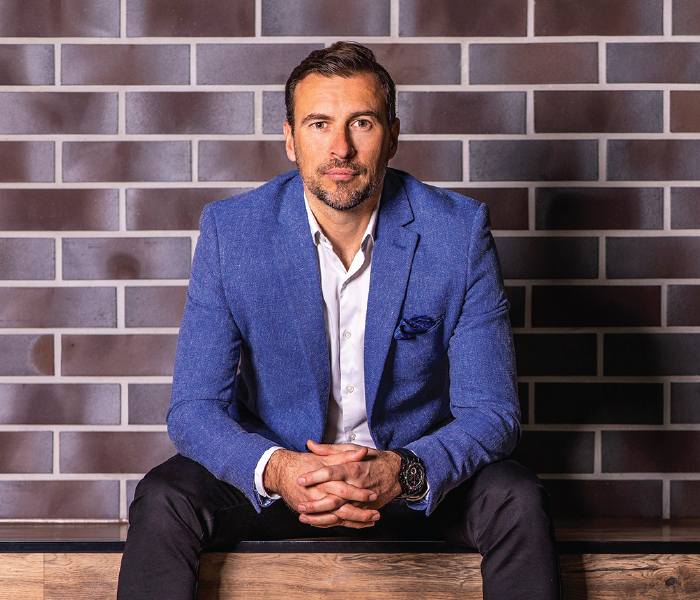By Jason T Smith
It’s often said that if you keep doing the same thing then you shouldn’t expect a different result. For more than a decade, I led my franchised physiotherapy business, the Back In Motion Health Group, with a traditional vertical organisational structure that mostly worked… up to a point, anyway. But I felt we could do much better.
Our model was unintentionally suffocating talented people through hierarchy and self-limiting position descriptions. Job titles and lines of reporting became discriminatory. Strategy and decisions were mostly formulated in a linear, top-down fashion. Conversations happened behind closed doors. Without noticing it, elitism and class divisions crept into our workplace. People were being artificially designated into executive, management and support strata. Influence was driven more by seniority and position, than by intelligence and merit. Creativity was dying.
The organisational structure that we had was quite normal – the traditional pyramid – but it certainly wasn’t optimal. Especially given that I was just about to set an unreasonable objective of doubling our group footprint over the next three years. We affectionately dubbed it ‘7/50/100’. It was the aspiration to have our brand accessible in seven states and territories of Australia, delivering $50 million worth of physiotherapy and related services, through 100 locations. So, it became time to shake things up.
3D MODEL
We didn’t just turn the traditional pyramidal organisation chart upsidedown as some have attempted. It wouldn’t have worked. We didn’t quite go flat or matrix in our management approach either. This was more about a change in our inner state, than it was a governance strategy. We needed to think, talk, and behave differently. We rounded out our organisational model into a threedimensional spherical expression with no top and no bottom.
Congruent with the spirit of innovation that characterised the change, we gave our new way of life its own name: ONEteam™.
We bounced forward. Or, as management literature might refer to it, we generated ‘adversarial growth’. We evolved through the pain of failures in the past, driven by the hope of the future. We reset our culture around the imperatives of over leadership and under-management. People had their titles stripped, and we dismantled traditional job descriptions. Colleagues were grouped into ‘functions’ and ‘pods’, and people no longer reported to a ‘boss’. We all served the mission rather than a (wo)man.
A MINIMALIST MOVEMENT
The principles of collaboration, distributed authority, and peer accountability became paramount. Individuals identified their best contributions to the workplace, kept their role profiles fluid to ensure agility and adaptability to changing demands, and no longer needed permission to get the job done. Performance was assessed in real time, financial records were laid bare, and strategic workflow became streamlined into the essentials. Minimalism reigned, as we sought to build a champion team, rather than a team of champions.
We even allowed peers to set their own remuneration bands within an overall salary cap, assist in the hiring and firing decisions, and decide their own bonus and incentive reward systems. Why? Because the owners can only guess what their people are motivated by, and inevitably will get it wrong some of the time.
We pulled down office walls, changed seating configurations to cluster people into more functional arrangements, and built additional breakout and meeting rooms. Reserved car parks were opened to all staff on a first-come basis, and we all shared the kitchen cleaning roster.
Even our meeting formats got challenged. We wanted less of them, and more decisions within them. Only those people with a contribution to make or an outcome to achieve were expected to attend. Every meeting was minuted and published for the whole team, with no secret business or hidden agendas.
A REAL SHAKE UP
In short, most things in our once-traditional workplace changed. Only a few essentials remained. We got turned outside-in and downside-up. A real shake up. But this change wasn’t haphazard or poorly considered. It was a metamorphosis of careful design. An intentionally new structure.
We bred a race of corporate freedom fighters. We fought against our own traditions, our flawed habits, and our ineffective strategies of the past. Today, we have achieved brand presence in more than seven states or territories, generated revenues in excess of AU$50 million per annum, and host more than 110 locations in Australia and New Zealand.
Our leadership revolution revealed an authentic and scalable way to give each team member the freedom to do what they love and excel at it. And in facilitating this, we gained so much more.
Jason T Smith is the founder of the Back In Motion Health Group, the Iceberg Leadership Institute and the SOS Health Foundation. In his book, Outside-In Downside-up Leadership (Major Street Publishing AU$29.95), Smith shares how he and his colleagues found the sweet spot between authentic collaboration and the holy grail of peer accountability in their workplace.
This article originally appeared in the December 2019 print edition of Leadership Matters, IML ANZ’s exclusive Member’s magazine. For editorial suggestions and enquiries, please contact karyl.estrella@managersandleaders.com.au.


